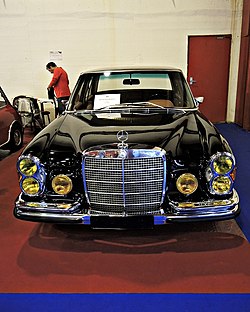
The Mercedes-Benz S-Class, formerly known as Sonderklasse, is a series of full-sized luxury sedans, limousines and armored sedans produced by the German automaker Mercedes-Benz. The S-Class is the designation for top-of-the-line Mercedes-Benz models and was officially introduced in 1972 with the W116, and has remained in use ever since. The S-Class is the flagship vehicle for Mercedes-Benz.

The Mercedes-Benz SLR McLaren is a grand tourer jointly developed by German automotive manufacturer Mercedes-Benz and British automobile manufacturer McLaren Automotive and sold from 2003 to 2010. When the car was developed, Mercedes-Benz owned 40 per cent of the McLaren Group and the car was produced in conjunction between the two companies. SLR is an abbreviation for "Sport Leicht Rennsport", a homage to the Mercedes-Benz 300 SLR which served as the car's inspiration. The car was offered in coupé, roadster and speedster bodystyles with the latter being a limited edition model.

The Mercedes-Benz 450SEL 6.9 is the high-performance version of the W116 S-Class saloon. It was based on the long-wheelbase version of W116 chassis introduced in 1972 and equipped with Mercedes-Benz M100 V8 engine and full hydropneumatic suspension system. The 450SEL 6.9 was presented to the public at the Geneva Auto Show in 1974 as the successor to the original high-performance saloon from Mercedes-Benz, the 300SEL 6.3 (1968–1972). Like the 300SEL 6.3 before it, the special displacement number (6.9) was affixed to the trunk lid to differentiate itself from the 450SEL. The 450SEL 6.9 was produced in a very limited number from 1975 to 1981.

The Mercedes-Benz W201 was the internal designation for the Mercedes 190 series sedans, a range of front-engine, rear drive, five passenger, four-door sedans manufactured over a single generation, from 1982 to 1993 as the company's first compact class automobile.

The Mercedes-Benz SL-Class is a grand touring sports car manufactured by Mercedes-Benz since 1954. The designation SL derives from the German Sport-Leicht.

The Mercedes-Benz CL-Class is a line of grand tourers which was produced by German automaker Mercedes-Benz, produced from 1992 to 2014. The name CL stands for the German Coupé Leicht (Coupé-Light) or Coupé Luxusklasse (Coupé-Luxury). It is considered by Mercedes as their premier model.

Brabus GmbH is a German high-performance automotive aftermarket tuning company founded in 1977 in Bottrop. Brabus specialises mainly in Mercedes-Benz, Maybach and Smart vehicles. They have also modified other vehicles too, including Porsche.

The Mercedes-Benz W211 is the third generation Mercedes-Benz E-Class made from 2002 to 2009 in sedan/saloon and station wagon/estate configurations – replacing the W210 E-Class models and superseded by the Mercedes-Benz W212 in 2009.

The Mercedes-Benz W126 is a series of passenger cars made by Daimler-Benz AG. It was marketed as the second generation of the Mercedes-Benz S-Class, and manufactured in sedan/saloon (1979–1991) as well as coupé (1981–1990) models, succeeding the company's W116 range. Mercedes-Benz introduced the 2-door C126 coupé model, marketed as the SEC, in September 1981. This generation was the first S-Class to have separate chassis codes for standard and long wheelbases and for coupé (C126).
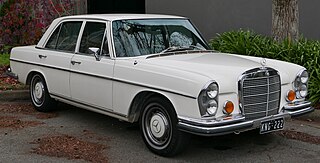
The Mercedes-Benz W108 and W109 are luxury cars produced by Mercedes-Benz from 1965 through to 1972. The line was an upgrade of the Mercedes-Benz W114/W115, to succeed the W111 and W112 fintail sedans. The cars were successful in West Germany and in export markets including North America and Southeast Asia. During the seven-year run, a total of 383,361 units were manufactured.
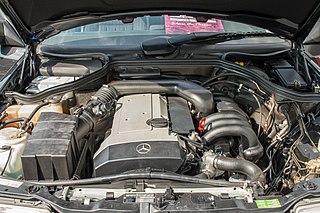
The Mercedes-Benz M104 is a straight-6 automobile engine produced from 1988 through 1999. It has a double overhead cam design with 4 valves per cylinder, and used a crossflow cylinder head. It replaced the M103 and was replaced by the M112 V6 starting in 1997. The bore spacing on all M104 engines is the same as M103 engines.

The R230 generation of the Mercedes-Benz SL-Class was introduced at the 2001 Frankfurt Motor Show and 2001 Bologna Motor Show, replacing the R129. The R230 underwent revisions in 2006 and 2008, and was superseded by the new SL-Class R231 in 2011.

Alpina Burkard Bovensiepen GmbH & Co. KG is an automobile manufacturing company based in Buchloe, in the Ostallgäu district of Bavaria, Germany that develops and sells high-performance versions of BMW cars. Alpina works closely with BMW and their processes are integrated into BMW's production lines, and is recognized by the German Ministry of Transport as an automobile manufacturer, in contrast to other performance specialists, which are aftermarket tuners. The Alpina B7 is produced at the same assembly line in Dingolfing, Germany, as BMW's own 7 Series. The B7's twin-turbo 4.4-litre V8 is assembled by hand at Alpina's facility in Buchloe, Germany, before being shipped to BMW for installation, and the assembled vehicle is then sent back to Alpina for finishing touches.

The Mercedes-Benz W111 was a chassis code given to a range of Mercedes-Benz vehicles produced between 1959 and 1971, including four-door saloons (1959-1968) and two-door coupés and cabriolets. Their bodywork featured distinctive tailfins that gave the models their Heckflosse nickname — German for "fintail".
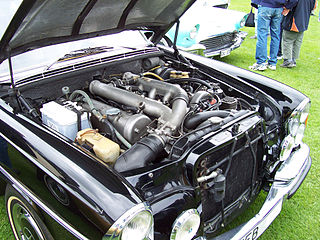
The Mercedes-Benz M100 engine was a 6.3 L (386.4 cu in) single overhead cam V8 produced by Mercedes-Benz between 1963 and 1981. The successor to the M189 version of the company's venerated 3.0 L (183.1 cu in) straight-6 M186, it was introduced in the flagship Mercedes-Benz 600. In 1968, it was fitted to the high-performance Mercedes-Benz 300SEL 6.3 sports sedan. The engine was enlarged to 6.8 L in 1975 for the Mercedes-Benz 450SEL 6.9 (1975-1981). Mercedes-Benz refers to it as a "6.9", despite its actual displacement.

Mercedes-Benz W202 is the internal designation for a compact sedan/saloon manufactured and marketed by Mercedes-Benz 1993–2000, as the first generation of the C-Class, now in its fifth generation. Replacing the 190 series/W201 in June 1993, the C-Class sedan was Mercedes' entry-level model until 1997, when the company launched the A-Class. Production reached 1,847,382 over model years 1994–2000.
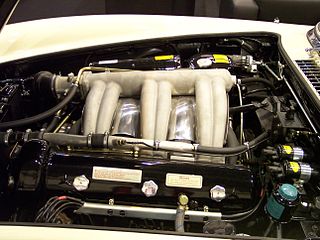
The Mercedes Benz M186 Engine was a 3.0–litre single overhead camshaft inline-6 developed in the early 1950s to power the company's new flagship 300 "Adenauer" (W186) four-door saloon. It made its debut at the Frankfurt Motor Show in April 1951.

The W213 Mercedes-Benz E-Class is the fifth-generation of the Mercedes-Benz E-Class. Sold from 2016, it is the successor to the W212/S212 E-Class models. The coupe/convertible models share the same platform as the sedan/wagon, in contrast to the previous generation. The high-performance Mercedes-AMG E 63 and E 63 S versions of the W213 have been available as well from 2016, and these are the only versions with V8 engines.

The Mercedes-AMG GT 4-Door Coupé is an executive car (E-segment) introduced in 2018 by Mercedes-AMG. It is marketed as a five-door variant of the AMG GT two-door sports car. Despite the name and style, the GT 4-Door Coupé is closely related to E63 wagon with its performance chassis, and is featured by the AMG-specific rear frame and a different front axle for better kinematics.

